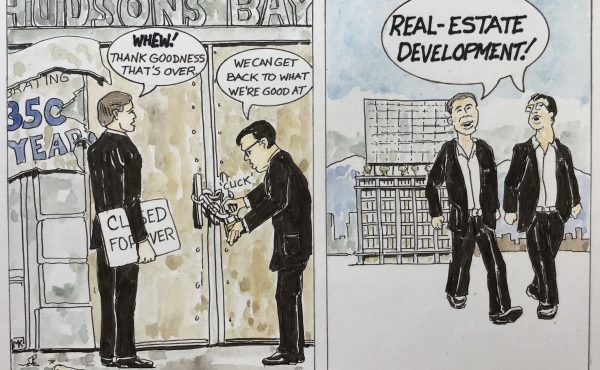
A fine-grain tour of Vancouver’s central areas, divided into twelve neighborhood walks, John Atkin and Andy Coupland’s new book The Changing City takes stock of the ever-evolving architectural assemblage that makes up Vancouver in 2010.
Author: John Atkin and Andy Coupland (Steller Press, 2010)
Review by Laura Kozak, re:place magazine
Vancouver historian, author, purveyor of local gems of information and heritage advocate John Atkin recently released his fourth book, The Changing City: Architecture and History Walking Tours in Central Vancouver in collaboration with Andy Coupland, Vancouver planner. In the lineage of Atkin’s previous books, including Vancouver Walks and Skytrain Explorer, The Changing City presents a mixture of architectural and urban history, here with an emphasis on recent architectural development and cultural projects contextualized by historical and Modernist Vancouver. Designed with an unusually tall, skinny format, the book is intended to fit in one’s back pocket, serving as both a walking-tour guidebook and a reference resource.
With a language and interest in detail usually reserved for purely historical texts, Atkin and Coupland tell the story of hundreds of Vancouver buildings, spanning the late 19th century to those begun as recently as 2010. Working between material histories, such as the story behind the Wall Centre’s two-tone tower, political contexts, like the shift of the primary downtown commercial core from Hastings Street to Granville Street, and shifting architectural or planning ambitions, The Changing City has the tone and diversity of a walking tour. The thoroughness of the research captured here, coupled with the ability to situate very recent projects in a century-long context, allow the book to answer questions about the things I’ve been wondering about for years.
Ever wonder why the entrance to the Hastings-Pender alley at the east side of Victory Square is so architecturally elegant? Atkin and Coupland will tell you that the Carter-Cotton Building at the corner of Hastings and Cambie was once the home of the Vancouver Province (now occupied by the Vancouver Film School). The third-story arched lane-bridge to the Edgett building (current home of the AIBC) on the corner of Pender and Cambie was put in to allow access to the paper’s printing plant. The Changing City also touches upon some of the public artworks that have begun more and more to populate the downtown core and False Creek areas of the city. Though less comprehensive than architectural and historical references, the artworks and artists mentioned are indexed along with buildings and architects in the back of the book.
John Atkin and Andy Coupland’s pocket-sized walking tours book, The Changing City, is an engaging read for architects, urbanists and historical enthusiasts alike – no previous experience required. It is both well-written and dense with information. The value of this book may well grow as it ages, in that it provides a crystal-clear, fine-grain snapshot of Vancouver at a peak of development in 2010.
***
Laura Kozak is a camping enthusiast, bibliophile and buddy of the Helen Pitt gallery. She has a BFA from Emily Carr, studies architecture at UBC and maintains an independent design practice at studio CAMP.


